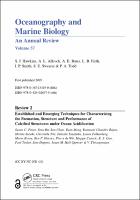Chapter 2 Established and Emerging Techniques for Characterising the Formation, Structure and Performance of Calcified Structures under Ocean Acidification
Proposal review
| dc.contributor.author | Fitzer, Susan C. | |
| dc.contributor.author | Bin San Chan, Vera | |
| dc.contributor.author | Meng, Yuan | |
| dc.contributor.author | Chandra Rajan, Kanmani | |
| dc.contributor.author | Suzuki, Michio | |
| dc.contributor.author | Not, Christelle | |
| dc.contributor.author | Toyofuku, Takashi | |
| dc.contributor.author | Fal, Laura | |
| dc.date.accessioned | 2019-10-21 11:59:15 | |
| dc.date.accessioned | 2020-04-01T10:08:59Z | |
| dc.date.available | 2020-04-01T10:08:59Z | |
| dc.date.issued | 2019 | |
| dc.identifier | 1005351 | |
| dc.identifier | OCN: 1135848536 | en_US |
| dc.identifier.uri | http://library.oapen.org/handle/20.500.12657/24760 | |
| dc.description.abstract | Ocean acidification (OA) is the decline in seawater pH and saturation levels of calcium carbonate (CaCO3) minerals that has led to concerns for calcifying organisms such as corals, oysters and mussels because of the adverse effects of OA on their biomineralisation, shells and skeletons. A range of cellular biology, geochemistry and materials science approaches have been used to explore biomineralisation. These techniques have revealed that responses to seawater acidification can be highly variable among species, yet the underlying mechanisms remain largely unresolved. To assess the impacts of global OA, researchers will need to apply a range of tools developed across disciplines, many of which are emerging and have not yet been used in this context. This review outlines techniques that could be applied to study OA-induced alterations in the mechanisms of biomineralisation and their ultimate effects on shells and skeletons. We illustrate how to characterise, quantify and monitor the process of biomineralisation in the context of global climate change and OA. We highlight the basic principles, as well as the advantages and disadvantages, of established, emerging and future techniques for OA researchers. A combination of these techniques will enable a holistic approach and better understanding of the potential impact of OA on biomineralisation and its consequences for marine calcifiers and associated ecosystems. | |
| dc.language | English | |
| dc.relation.ispartofseries | Ocean Engineering & Oceanography | |
| dc.subject.classification | thema EDItEUR::R Earth Sciences, Geography, Environment, Planning | en_US |
| dc.subject.other | Structures | |
| dc.subject.other | techniques | |
| dc.subject.other | ocean acidification | |
| dc.title | Chapter 2 Established and Emerging Techniques for Characterising the Formation, Structure and Performance of Calcified Structures under Ocean Acidification | |
| dc.type | chapter | |
| oapen.relation.isPublishedBy | 7b3c7b10-5b1e-40b3-860e-c6dd5197f0bb | |
| oapen.relation.isPartOfBook | 24ff3850-35d3-456a-a529-64c315cfe2b5 | |
| oapen.relation.isbn | 9780429026379 | |
| oapen.imprint | CRC Press | |
| oapen.pages | 40 | |
| oapen.remark.public | 3-8-2020 - No DOI registered in CrossRef for ISBN 9780367134150 | |
| oapen.identifier.ocn | 1135848536 | |
| peerreview.anonymity | Single-anonymised | |
| peerreview.id | bc80075c-96cc-4740-a9f3-a234bc2598f1 | |
| peerreview.open.review | No | |
| peerreview.publish.responsibility | Publisher | |
| peerreview.review.stage | Pre-publication | |
| peerreview.review.type | Proposal | |
| peerreview.reviewer.type | Internal editor | |
| peerreview.reviewer.type | External peer reviewer | |
| peerreview.title | Proposal review | |
| oapen.review.comments | Taylor & Francis open access titles are reviewed as a minimum at proposal stage by at least two external peer reviewers and an internal editor (additional reviews may be sought and additional content reviewed as required). | |
| oapen.review.comments | Taylor & Francis open access titles are reviewed as a minimum at proposal stage by at least two external peer reviewers and an internal editor (additional reviews may be sought and additional content reviewed as required). |

